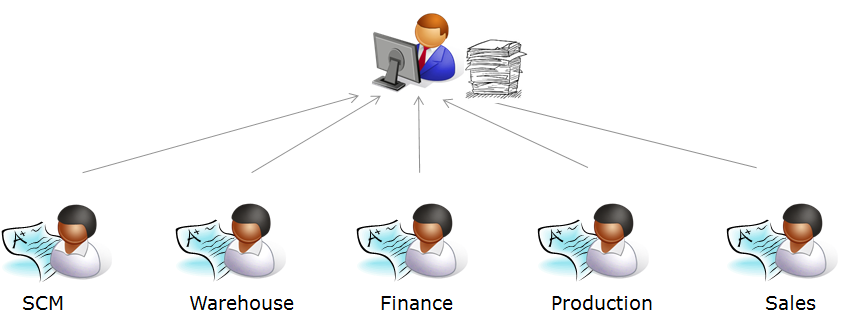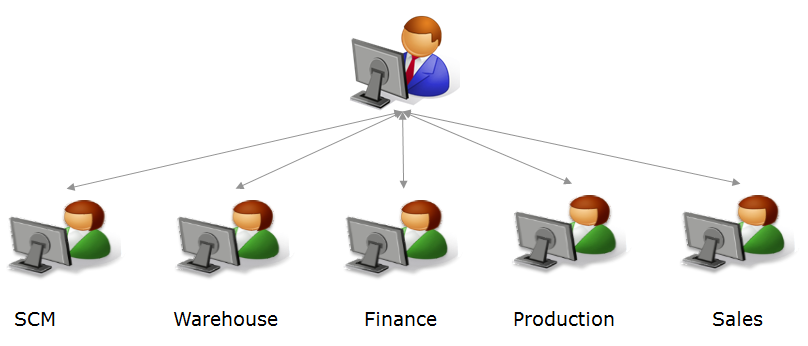Data Governance Models │Which Model Best Suits Your Organization

Inside Data Governance: Part 2 │Data Governance Models
In part one of this series, we defined data governance and looked at the missteps that lead to massive cleanup projects. In this post, we will examine common data governance models and which work best for different types of organizations.
No single data governance model fits all organizations. A variety of models are commonly leveraged in today’s businesses, with some fitting smaller or larger organizations better and others making more sense for various structures or business needs. Let’s take a look at four of the most common data governance models:
1. De-centralized Execution – Single Business Unit
This data governance model is characterized by individual business users maintaining their own master data. This model ensures that the data is created by the local users who are typically the consumers of this master data.
Users, benefits and caveats:
- Best for small organizations, such as a single plant or single company
- Offers simpler data maintenance
- Requires a lot of agility in order to set up master data
- No shared master data with other business units
- Delivers a shorter life span for master data
While this model is simpler and can make for faster master data setup, unless managed properly, users can also see huge inconsistencies in data. The following strategies and tactics can help ensure this model works effectively:
- Clearly define data ownership and limit this to a handful of experts within the organization
- Ensure clear documentation of how each field is to be populated and the meaning of each value for each field
- If budget permits, automated tools can control the consistency of data
- Set up controls and audits to quickly fix any inconsistencies
- Limit the role of data governance organization to building processes and procedures and performing periodic data audits
2. De-Centralized Execution – Multiple Business Units
This data governance model is characterized by individual business users maintaining their own master data. In this scenario, we have multiple business units working with shared customers, materials and vendors.
Users, benefits and caveats:
- Best for small and medium organizations, with multiple plants and/or multiple companies involved
- Offers simpler data maintenance
- Requires a lot of agility in order to set up master data
- Allows for shared master data with other business units
- Delivers a shorter life span for master data
As noted, while this data governance model is simpler and can make for faster master data setup, it, can also result in inconsistent data with a far reaching impact when multiple parties are involved. There is a definite need to control this model as very common side effects like duplicate master data and inconsistent data resulting in inconsistent or meaningless reporting can become troublesome. In order for this model to work effectively it is key to:
- Leverage automated tools that can ensure the consistency of data – independent of who creates the master data
- Limit the number of fields that are maintained and let the rest of the fields be derived based on various customized profiles
- Ensure clear documentation of how each field is to be populated and what is the meaning of each value for each field
- Set up controls and audits to quickly fix any inconsistencies
- Identify controlled fields that have an impact across departments and business units, then enforce strict controls on who maintains these and clearly define what each field means
- The role of the data governance organization should not be limited to building processes and procedures and performing periodic data audits, but should also include owning the automated tools and keeping them tuned to business requirements
3. Centralized Governance – Single or Multiple Business Units
This third data governance model is characterized by single or multiple business units centralizing the maintenance of master data. In this model, one central organization owns setting up master data based on requests coming from the consumers of the master data.

Users, benefits and caveats:
- Best for large and medium organizations with multiple plants, and/or multiple companies
- Brings complex data requirements
- Supports a longer life span for master data, with a longer product life cycle and long term relationships with customers and vendors
- Involves a lot of legal implications and must be kept up to date based on extrinsic factors like government regulations
- Allows for shared master data with other business units
- Entails a larger system landscape and requires master data to be distributed to various systems
This data governance model can ensure a high level of control of master data, but it is often characterized by delays in setting up master data and requires a formal and larger data governance organization. As well, in this model there is high probability that the master data created is consistent and introduction of changes and process improvements is quicker because there are a limited number of users setting up master data. In order to improve the model, organizations should:
- Build automated processes to provide transparency and visibility to the process of master data maintenance
- Establish KPIs for different master data requests and ensure the size of the data governance organization scales based on the requirements
- Confirm effective communication takes place between the business and master data team to ensure that master data rules are tuned to changes in the business and products
- The role of the data governance organization should not be limited to processes and procedures but should also include maintenance of master data, including process adjustments to meet business needs
4. Centralized Data Governance & Decentralized Execution
This last data governance model is characterized by a centralized governance body defining the framework of controls and individual businesses creating their individual parts of master data.

Users, benefits and caveats:
- Best for large and medium organizations with multiple plant and/or multiple companies
- Brings complex data requirements but requires agility in the creation of master data
- Supports a longer life span for master data, with a longer product life cycle and long term relationships with customers and vendors
- Involves a lot of legal implications and must be kept up to date based on extrinsic factors like government regulations
- Allows for shared master data with other business units
- Entails a larger system landscape and requires master data to be distributed to various systems
This data governance model can ensure agility, but at the same time organizations must ensure the proper controls are in place, where needed. There is a shared responsibility in this model between the data governance organization and the business.
To effectively leverage this model organizations must:
- Identify controlled fields that have an impact across departments and business units, and then assign ownership to centralize maintenance
- Build automated tools to avoid de-duplication at the source
- Ensure a central organization mediate between various departments and business units when there is a conflict
- Automate the request process and leverage automated tools to help local businesses consistently manage data
- Set up controls and audits to quickly fix any inconsistencies
- The role of the data governance organization should not be limited to processes and procedures but should also include maintenance of part of the master data, including making process adjustments to meet business needs. Here, the master data team also plays a mentoring role to the business in order to ensure consistency
All four data governance models work, provided a proper control framework is in place, whether this is manual or automated. The level of automation required depends on multiple factors, including:
- The size of the company
- The structure of the company
- The complexity of the company’s master data
- The number of master data records created and updated
- The length of the master data life cycle
- The impact of master data from reporting and legal perspective
Learn More About Data Governance
Want to learn more about how to manage your Master Data? For more information on it.mds, please visit the NTT DATA Business Solutions Addstore. You will gain an insight into how it.mds can make your master data business oriented, provide better governance throughout your business, and deliver greater compliance through business-driven workflows.
In part three of this series, we will walk through seven key steps to data governance.

